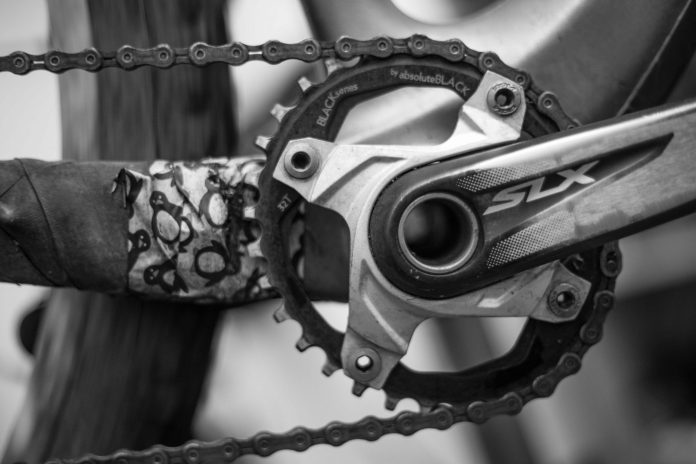It was certainly a gamble to use an oval chainring from Absolute Black for the first time ever during a 24 hour mountain bike race, but did it pay off, back fire or did I just not notice any difference?
Oval or non circular shaped chain rings aren’t new, but what is relatively new is the way they are aligned. A new generation of companies emerged making them: Rotor Q Rings, Osymetric, B-Labs and recently Absolute Black to name a few. On road bikes they’ve been around a while with Bradley Wiggins and Chris Froome famously using Osymetric to win the Tour de France. However until recently they weren’t suitable for MTBs, as the chain fell off too much and they don’t tend to shift gears as well. However the new narrow wide teeth design on 1×10 speed setups from Absolute Black and B-Labs by Bionicon should eliminate this by ensuring the chain stays on much better on rough ground without a front derailleur or chain guide, just a clutch rear derailleur.
Buy one here reduced
Why the shape works in theory
Shimano’s infamous chainring failure called Bio-Pace put the oval section at the wrong position, effectively putting greater power requirements at the weakest part of the leg spinning motion – hence why it was so unpopular.
What most companies now do is make the ring bigger at the down stroke and narrower at the mid stroke. This is matching the wide part with the front foot down-stroke when you’re using your strongest quad muscles. On the mid-stroke you’re pulling up using your hamstrings via the SPDs attached to the pedals, this is the weakest part so less chain teeth engage.
So on my 32 tooth ‘ring’ I am pushing 34 down and 30 ‘up’, in theory this makes the pedal cycle more efficient as you can maximise power where it’s needed. This idea certainly helps balance out someone with an inefficient spinning action and in theory reduce fatigue.

How does it ride in practice.
At first the shape was pretty awkward to pedal. It felt like it was much harder work on the down stroke and too easy on the midpoint. This was especially true on the uphills where it felt like my legs got tired more than normal from pushing straight down at higher resistance rather than spinning a circle.
However after less than one ride without disaster I jumped in at the deep end using the 32 tooth ring from Absolute Black for the UK 24 hour solo MTB championships in Scotland.
During the race the motion gradually felt smoother and as the hours clocked up my legs appeared to fatigue a lot less than I imagined they might. The question is, was this down to the efficiency of the rings design or just correct pacing and also would it last for the whole 24 hours?!
Oval rings are certainly not faster overall, your peak power output feels the same and studies seem to back this up. It feels just as hardwork pushing down on the pedals, however for some reason it does seem to reduce how tired your legs feel as the miles clock up. The practise must have backed up the theory in so much as my quads warmed up and worked hard but coped fine, but I didn’t get issues with cramp or tight hamstrings nor calf muscles which you might expect after a long ride.
The only output performance edge I noticed was that I could put more power down in techy pedally sections quicker and more easily than expected. I also seemed to get out of trouble better when that short steep climb surprised me in the wrong gear. Does this mean it’s ideal for Enduro riding? If the chain stays on OK then I think they do suit that type of riding.
I ended up winning the British senior men title in the 24hr race therefore the chainrings didn’t hinder me, I just kept going so I guess they must have been a success, even if I can’t 100% put my finger on why!
Other features to note
I used the Absolute Black ring in a 1×10 setup with no chainguide, the chain has only once fallen off and that was when the clutch was left switched off on my rear derailleur on a rough descent. The chain certainly flaps around more due to the rapid changes in tension from the rings shape and that’s what makes me hesitant to use one for Enduro racing, certainly without a chain guide. As the ring wears I expect it to fall off more although it’s not wearing out any faster or slower than comparative circular rings.
The 32 tooth Absolute ring comes with bolt threads machined, as there’s no space for traditional nuts in the design. It was super easy to attach and setup correctly with an indicator arrow for alignment.

Conclusions
An oval chainring won’t make you faster, I doubt it increases power output, it’s more a preference thing, hence why Bradley Wiggins ditched them after winning. For me it seems logical to use them on a MTB when the pedaling action is generally a lot more erratic and variable depending on terrain and trail surface.
While it’s not worth rushing out to buy one, if you need a new chainring then try an Absolute Black one, they’re pretty cheap and won’t do any harm to your performance. It might genuinely help in certain situations, just don’t expect miracles. I will certainly keep using mine.Buy one here reduced
I will update as they wear and how the chain stays on for more aggressive Enduro riding.
